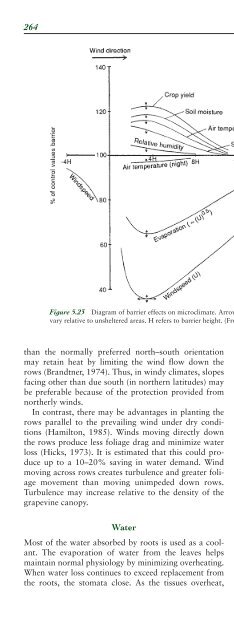- Page 2:
Third Edition Wine Science Principl
- Page 6:
Third Edition Wine Science Principl
- Page 10:
The book is dedicated to the miracu
- Page 14:
About the Author xiii Preface xv Ac
- Page 18:
Contents ix Sugars 274 Pectins, Gum
- Page 22:
Contents xi Analysis of Variance 67
- Page 26:
The author received his bachelor’
- Page 30:
There are three pillars of wine sci
- Page 34:
Without the astute observations of
- Page 38:
1 Introduction Grapevine and Wine O
- Page 42:
Grapevine and Wine Origin 3 and oth
- Page 46:
Commercial Importance of Grapes and
- Page 50:
Wine Classifi cation 7 Figure 1.2 W
- Page 54:
Wine Classifi cation 9 Table 1.1 Cl
- Page 58:
Health-related Aspects of Wine Cons
- Page 62:
References 13 Although wine consump
- Page 66:
2 Grape Species and Varieties Intro
- Page 70:
The Genus Vitis 17 Figure 2.3 Prope
- Page 74:
Geographic Origin and Distribution
- Page 78:
Domestication of Vitis vinifera 21
- Page 82:
Domestication of Vitis vinifera 23
- Page 86:
Domestication of Vitis vinifera 25
- Page 90:
Cultivar Origins 27 Table 2.2 Class
- Page 94:
Cultivar Origins 29 ‘Gouais blanc
- Page 98:
Grapevine Improvement 31 For exampl
- Page 102:
Grapevine Improvement 33 practical
- Page 106:
Grapevine Improvement 35 Figure 2.1
- Page 110:
Grapevine Improvement 37 Such prope
- Page 114:
Grapevine Improvement 39 Currently,
- Page 118:
Grapevine Improvement 41 mechanical
- Page 122:
Grapevine Improvement 43 ‘Tramine
- Page 126:
Suggested Readings 45 styles; posse
- Page 130:
References 47 Chicki, L., Nichols,
- Page 134:
References 49 Soulie, O., Roustan,
- Page 138:
Vegetative Structure and Function 5
- Page 142:
Vegetative Structure and Function 5
- Page 146:
Vegetative Structure and Function 5
- Page 150:
Vegetative Structure and Function 5
- Page 154:
Vegetative Structure and Function 5
- Page 158:
Vegetative Structure and Function 6
- Page 162:
Vegetative Structure and Function 6
- Page 166:
Vegetative Structure and Function 6
- Page 170:
Reproductive Structure and Developm
- Page 174:
Reproductive Structure and Developm
- Page 178:
Reproductive Structure and Developm
- Page 182:
Reproductive Structure and Developm
- Page 186:
Reproductive Structure and Developm
- Page 190:
Reproductive Structure and Developm
- Page 194:
Reproductive Structure and Developm
- Page 198:
Reproductive Structure and Developm
- Page 202:
Reproductive Structure and Developm
- Page 206:
Reproductive Structure and Developm
- Page 210:
Reproductive Structure and Developm
- Page 214:
Reproductive Structure and Developm
- Page 218:
Reproductive Structure and Developm
- Page 222:
Reproductive Structure and Developm
- Page 226:
Reproductive Structure and Developm
- Page 230:
Reproductive Structure and Developm
- Page 234:
Suggested Readings 99 Technical Con
- Page 238:
References 101 mit Headspace-Inhalt
- Page 242:
References 103 Huglin, P., and Balt
- Page 246:
References 105 Pratt, C. (1971) Rep
- Page 250:
References 107 West, D. W., and Tay
- Page 254:
Vine Cycle and Vineyard Activity 10
- Page 258:
Management of Vine Growth 111 conti
- Page 262:
Management of Vine Growth 113 Figur
- Page 266:
Management of Vine Growth 115 Figur
- Page 270:
Management of Vine Growth 117 Figur
- Page 274:
Management of Vine Growth 119 shoul
- Page 278:
Management of Vine Growth 121 Figur
- Page 282:
Management of Vine Growth 123 Initi
- Page 286:
Management of Vine Growth 125 (Fig.
- Page 290:
Management of Vine Growth 127 beari
- Page 294:
Management of Vine Growth 129 vigor
- Page 298:
Management of Vine Growth 131 Table
- Page 302:
Management of Vine Growth 133 Table
- Page 306:
Management of Vine Growth 135 bilat
- Page 310:
Management of Vine Growth 137 photo
- Page 314:
Management of Vine Growth 139 The v
- Page 318:
Rootstock 141 Table 4.7 Important c
- Page 322:
Rootstock 143 A Soil depth (m) B So
- Page 326:
Vine Propagation and Grafting 145 F
- Page 330:
Vine Propagation and Grafting 147 u
- Page 334:
Vine Propagation and Grafting 149 p
- Page 338:
Irrigation 151 clusters, and increa
- Page 342:
Irrigation 153 water content by com
- Page 346:
Irrigation 155 Timing and Need for
- Page 350:
Irrigation 157 be leached away. Cal
- Page 354:
Irrigation 159 Figure 4.30 Comparis
- Page 358:
Fertilization 161 Figure 4.31 Measu
- Page 362:
Fertilization 163 Figure 4.33 Relat
- Page 366:
Fertilization 165 Figure 4.35 Relat
- Page 370:
Fertilization 167 chloroplasts. Nuc
- Page 374:
Fertilization 169 some proteins. It
- Page 378:
Fertilization 171 usually begins ap
- Page 382:
Fertilization 173 Fertilizer-derive
- Page 386:
Disease, Pest, and Weed Control 175
- Page 390:
Disease, Pest, and Weed Control 177
- Page 394:
Disease, Pest, and Weed Control 179
- Page 398:
Disease, Pest, and Weed Control 181
- Page 402:
Disease, Pest, and Weed Control 183
- Page 406:
Disease, Pest, and Weed Control 185
- Page 410:
Disease, Pest, and Weed Control 187
- Page 414:
Disease, Pest, and Weed Control 189
- Page 418:
Disease, Pest, and Weed Control 191
- Page 422:
Disease, Pest, and Weed Control 193
- Page 426:
Disease, Pest, and Weed Control 195
- Page 430:
Disease, Pest, and Weed Control 197
- Page 434:
Disease, Pest, and Weed Control 199
- Page 438:
Disease, Pest, and Weed Control 201
- Page 442:
Disease, Pest, and Weed Control 203
- Page 446:
Disease, Pest, and Weed Control 205
- Page 450:
Disease, Pest, and Weed Control 207
- Page 454:
Disease, Pest, and Weed Control 209
- Page 458:
Disease, Pest, and Weed Control 211
- Page 462:
Harvesting 213 Figure 4.58 Schemati
- Page 466:
Harvesting 215 Red-free G-G (μmol
- Page 470:
Harvesting 217 Figure 4.62 Types of
- Page 474:
Harvesting 219 camera to measure li
- Page 478:
Suggested Readings 221 attributes m
- Page 482:
References 223 Flaherty, D. L., Chr
- Page 486:
References 225 glassy-winged sharps
- Page 490:
References 227 Cosmo, I., Comuzzi,
- Page 494:
References 229 Golino, D. A. (1993)
- Page 498:
References 231 Kirk, J. L., Beaudet
- Page 502:
References 233 Munkvold, G., and Ma
- Page 506:
References 235 Sauer, A. E., and Ka
- Page 510:
References 237 Ureta, F., Boidron,
- Page 514: 5 Site Selection and Climate The vi
- Page 518: Soil Infl uences 241 particularly r
- Page 522: Soil Infl uences 243 roots. This ma
- Page 526: Soil Infl uences 245 released durin
- Page 530: Topographic Infl uences 247 Figure
- Page 534: Atmospheric Infl uences 249 Figure
- Page 538: Atmospheric Infl uences 251 Table 5
- Page 542: Atmospheric Infl uences 253 saturat
- Page 546: Atmospheric Infl uences 255 Figure
- Page 550: Atmospheric Infl uences 257 Air tem
- Page 554: Atmospheric Infl uences 259 pushed
- Page 558: Atmospheric Infl uences 261 Figure
- Page 562: Atmospheric Infl uences 263 Figure
- Page 568: 266 5. Site Selection and Climate W
- Page 572: 268 5. Site Selection and Climate P
- Page 576: 6 Chemical Constituents of Grapes a
- Page 580: 272 6. Chemical Constituents of Gra
- Page 584: 274 6. Chemical Constituents of Gra
- Page 588: 276 6. Chemical Constituents of Gra
- Page 592: 278 6. Chemical Constituents of Gra
- Page 596: 280 6. Chemical Constituents of Gra
- Page 600: 282 6. Chemical Constituents of Gra
- Page 604: 284 6. Chemical Constituents of Gra
- Page 608: 286 6. Chemical Constituents of Gra
- Page 612: 288 6. Chemical Constituents of Gra
- Page 616:
290 6. Chemical Constituents of Gra
- Page 620:
292 6. Chemical Constituents of Gra
- Page 624:
294 6. Chemical Constituents of Gra
- Page 628:
296 6. Chemical Constituents of Gra
- Page 632:
298 6. Chemical Constituents of Gra
- Page 636:
300 6. Chemical Constituents of Gra
- Page 640:
302 6. Chemical Constituents of Gra
- Page 644:
304 6. Chemical Constituents of Gra
- Page 648:
306 6. Chemical Constituents of Gra
- Page 652:
308 6. Chemical Constituents of Gra
- Page 656:
310 6. Chemical Constituents of Gra
- Page 660:
312 6. Chemical Constituents of Gra
- Page 664:
314 6. Chemical Constituents of Gra
- Page 668:
316 6. Chemical Constituents of Gra
- Page 672:
318 6. Chemical Constituents of Gra
- Page 676:
320 6. Chemical Constituents of Gra
- Page 680:
322 6. Chemical Constituents of Gra
- Page 684:
324 6. Chemical Constituents of Gra
- Page 688:
326 6. Chemical Constituents of Gra
- Page 692:
328 6. Chemical Constituents of Gra
- Page 696:
330 6. Chemical Constituents of Gra
- Page 700:
7 Fermentation The theory and pract
- Page 704:
334 7. Fermentation extracted (gene
- Page 708:
336 7. Fermentation material. The s
- Page 712:
338 7. Fermentation Occasionally, a
- Page 716:
340 7. Fermentation obtained using
- Page 720:
342 7. Fermentation acidity (higher
- Page 724:
344 7. Fermentation oxidation. High
- Page 728:
346 7. Fermentation Where permissib
- Page 732:
348 7. Fermentation Botrytis-infect
- Page 736:
350 7. Fermentation DECOLORATION AN
- Page 740:
352 7. Fermentation at this time de
- Page 744:
354 7. Fermentation This provides a
- Page 748:
356 7. Fermentation substrate, S. c
- Page 752:
358 7. Fermentation by many organis
- Page 756:
360 7. Fermentation Figure 7.15 Cor
- Page 760:
362 7. Fermentation and Sablayrolle
- Page 764:
364 7. Fermentation Figure 7.19 Sta
- Page 768:
366 7. Fermentation As noted, grape
- Page 772:
368 7. Fermentation Figure 7.21 The
- Page 776:
370 7. Fermentation relatively litt
- Page 780:
372 7. Fermentation recessive genes
- Page 784:
374 7. Fermentation Figure 7.26 Est
- Page 788:
376 7. Fermentation ammonia (MEP2)
- Page 792:
378 7. Fermentation PHENOLS The phe
- Page 796:
380 7. Fermentation Figure 7.29 Yea
- Page 800:
382 7. Fermentation Table 7.2 The r
- Page 804:
384 7. Fermentation Figure 7.30 Eff
- Page 808:
386 7. Fermentation % Residue 100 8
- Page 812:
388 7. Fermentation sensory attribu
- Page 816:
390 7. Fermentation production of l
- Page 820:
392 7. Fermentation lactic acid bac
- Page 824:
394 7. Fermentation require a high
- Page 828:
396 7. Fermentation synthesis of ac
- Page 832:
398 7. Fermentation This can libera
- Page 836:
400 7. Fermentation increased glyce
- Page 840:
402 7. Fermentation joint malolacti
- Page 844:
404 7. Fermentation Suggested Readi
- Page 848:
406 7. Fermentation Cabras, P., and
- Page 852:
408 7. Fermentation June 19-23, 200
- Page 856:
410 7. Fermentation Garcia, A., Car
- Page 860:
412 7. Fermentation Kunkee, R. E.,
- Page 864:
414 7. Fermentation Park, S. K., Mo
- Page 868:
416 7. Fermentation Sinclair, D.A.,
- Page 872:
8 Postfermentation Treatments and R
- Page 876:
420 8. Postfermentation Treatments
- Page 880:
422 8. Postfermentation Treatments
- Page 884:
424 8. Postfermentation Treatments
- Page 888:
426 8. Postfermentation Treatments
- Page 892:
428 8. Postfermentation Treatments
- Page 896:
430 8. Postfermentation Treatments
- Page 900:
432 8. Postfermentation Treatments
- Page 904:
434 8. Postfermentation Treatments
- Page 908:
436 8. Postfermentation Treatments
- Page 912:
438 8. Postfermentation Treatments
- Page 916:
440 8. Postfermentation Treatments
- Page 920:
442 8. Postfermentation Treatments
- Page 924:
444 8. Postfermentation Treatments
- Page 928:
446 8. Postfermentation Treatments
- Page 932:
448 8. Postfermentation Treatments
- Page 936:
450 8. Postfermentation Treatments
- Page 940:
452 8. Postfermentation Treatments
- Page 944:
454 8. Postfermentation Treatments
- Page 948:
456 8. Postfermentation Treatments
- Page 952:
458 8. Postfermentation Treatments
- Page 956:
460 8. Postfermentation Treatments
- Page 960:
462 8. Postfermentation Treatments
- Page 964:
464 8. Postfermentation Treatments
- Page 968:
466 8. Postfermentation Treatments
- Page 972:
468 8. Postfermentation Treatments
- Page 976:
470 8. Postfermentation Treatments
- Page 980:
472 8. Postfermentation Treatments
- Page 984:
474 8. Postfermentation Treatments
- Page 988:
476 8. Postfermentation Treatments
- Page 992:
478 8. Postfermentation Treatments
- Page 996:
480 8. Postfermentation Treatments
- Page 1000:
482 8. Postfermentation Treatments
- Page 1004:
484 8. Postfermentation Treatments
- Page 1008:
486 8. Postfermentation Treatments
- Page 1012:
488 8. Postfermentation Treatments
- Page 1016:
490 8. Postfermentation Treatments
- Page 1020:
492 8. Postfermentation Treatments
- Page 1024:
494 8. Postfermentation Treatments
- Page 1028:
496 8. Postfermentation Treatments
- Page 1032:
498 8. Postfermentation Treatments
- Page 1036:
500 8. Postfermentation Treatments
- Page 1040:
502 8. Postfermentation Treatments
- Page 1044:
504 8. Postfermentation Treatments
- Page 1048:
506 8. Postfermentation Treatments
- Page 1052:
508 8. Postfermentation Treatments
- Page 1056:
510 8. Postfermentation Treatments
- Page 1060:
512 8. Postfermentation Treatments
- Page 1064:
514 8. Postfermentation Treatments
- Page 1068:
516 8. Postfermentation Treatments
- Page 1072:
518 8. Postfermentation Treatments
- Page 1076:
9 Specifi c and Distinctive Wine St
- Page 1080:
522 9. Specifi c and Distinctive Wi
- Page 1084:
524 9. Specifi c and Distinctive Wi
- Page 1088:
526 9. Specifi c and Distinctive Wi
- Page 1092:
528 9. Specifi c and Distinctive Wi
- Page 1096:
530 9. Specifi c and Distinctive Wi
- Page 1100:
532 9. Specifi c and Distinctive Wi
- Page 1104:
534 9. Specifi c and Distinctive Wi
- Page 1108:
536 9. Specifi c and Distinctive Wi
- Page 1112:
538 9. Specifi c and Distinctive Wi
- Page 1116:
540 9. Specifi c and Distinctive Wi
- Page 1120:
542 9. Specifi c and Distinctive Wi
- Page 1124:
544 9. Specifi c and Distinctive Wi
- Page 1128:
546 9. Specifi c and Distinctive Wi
- Page 1132:
548 9. Specifi c and Distinctive Wi
- Page 1136:
550 9. Specifi c and Distinctive Wi
- Page 1140:
552 9. Specifi c and Distinctive Wi
- Page 1144:
554 9. Specifi c and Distinctive Wi
- Page 1148:
556 9. Specifi c and Distinctive Wi
- Page 1152:
558 9. Specifi c and Distinctive Wi
- Page 1156:
560 9. Specifi c and Distinctive Wi
- Page 1160:
562 9. Specifi c and Distinctive Wi
- Page 1164:
564 9. Specifi c and Distinctive Wi
- Page 1168:
566 9. Specifi c and Distinctive Wi
- Page 1172:
568 9. Specifi c and Distinctive Wi
- Page 1176:
570 9. Specifi c and Distinctive Wi
- Page 1180:
572 9. Specifi c and Distinctive Wi
- Page 1184:
574 9. Specifi c and Distinctive Wi
- Page 1188:
576 9. Specifi c and Distinctive Wi
- Page 1192:
578 10. Wine Laws, Authentication,
- Page 1196:
580 10. Wine Laws, Authentication,
- Page 1200:
582 10. Wine Laws, Authentication,
- Page 1204:
584 10. Wine Laws, Authentication,
- Page 1208:
586 10. Wine Laws, Authentication,
- Page 1212:
588 10. Wine Laws, Authentication,
- Page 1216:
590 10. Wine Laws, Authentication,
- Page 1220:
592 10. Wine Laws, Authentication,
- Page 1224:
594 10. Wine Laws, Authentication,
- Page 1228:
596 10. Wine Laws, Authentication,
- Page 1232:
598 10. Wine Laws, Authentication,
- Page 1236:
600 10. Wine Laws, Authentication,
- Page 1240:
602 10. Wine Laws, Authentication,
- Page 1244:
604 10. Wine Laws, Authentication,
- Page 1248:
606 10. Wine Laws, Authentication,
- Page 1252:
608 10. Wine Laws, Authentication,
- Page 1256:
610 10. Wine Laws, Authentication,
- Page 1260:
612 10. Wine Laws, Authentication,
- Page 1264:
614 10. Wine Laws, Authentication,
- Page 1268:
616 10. Wine Laws, Authentication,
- Page 1272:
618 10. Wine Laws, Authentication,
- Page 1276:
620 10. Wine Laws, Authentication,
- Page 1280:
622 10. Wine Laws, Authentication,
- Page 1284:
624 10. Wine Laws, Authentication,
- Page 1288:
626 10. Wine Laws, Authentication,
- Page 1292:
628 10. Wine Laws, Authentication,
- Page 1296:
630 10. Wine Laws, Authentication,
- Page 1300:
632 10. Wine Laws, Authentication,
- Page 1304:
634 10. Wine Laws, Authentication,
- Page 1308:
636 10. Wine Laws, Authentication,
- Page 1312:
638 10. Wine Laws, Authentication,
- Page 1316:
640 10. Wine Laws, Authentication,
- Page 1320:
642 11. Sensory Perception and Wine
- Page 1324:
644 11. Sensory Perception and Wine
- Page 1328:
646 11. Sensory Perception and Wine
- Page 1332:
648 11. Sensory Perception and Wine
- Page 1336:
650 11. Sensory Perception and Wine
- Page 1340:
652 11. Sensory Perception and Wine
- Page 1344:
654 11. Sensory Perception and Wine
- Page 1348:
656 11. Sensory Perception and Wine
- Page 1352:
658 11. Sensory Perception and Wine
- Page 1356:
660 11. Sensory Perception and Wine
- Page 1360:
662 11. Sensory Perception and Wine
- Page 1364:
664 11. Sensory Perception and Wine
- Page 1368:
666 11. Sensory Perception and Wine
- Page 1372:
668 11. Sensory Perception and Wine
- Page 1376:
670 11. Sensory Perception and Wine
- Page 1380:
672 11. Sensory Perception and Wine
- Page 1384:
674 11. Sensory Perception and Wine
- Page 1388:
676 11. Sensory Perception and Wine
- Page 1392:
678 11. Sensory Perception and Wine
- Page 1396:
680 11. Sensory Perception and Wine
- Page 1400:
682 11. Sensory Perception and Wine
- Page 1404:
684 11. Sensory Perception and Wine
- Page 1408:
12 Wine and Health Introduction The
- Page 1412:
688 12. Wine and Health high. It en
- Page 1416:
690 12. Wine and Health Figure 12.1
- Page 1420:
692 12. Wine and Health Circulation
- Page 1424:
694 12. Wine and Health observation
- Page 1428:
696 12. Wine and Health (Dixon et a
- Page 1432:
698 12. Wine and Health a lifetime.
- Page 1436:
700 12. Wine and Health formic acid
- Page 1440:
702 12. Wine and Health Waterhouse,
- Page 1444:
704 12. Wine and Health La Porte, R
- Page 1448:
706 12. Wine and Health Verhagen, J
- Page 1452:
708 Glossary Appellation Control (A
- Page 1456:
710 Glossary Cork, the outer bark o
- Page 1460:
712 Glossary Hexaploid, an organism
- Page 1464:
714 Glossary hydrophobic nature of
- Page 1468:
716 Glossary Summerwood, the small-
- Page 1472:
This page intentionally left blank
- Page 1476:
720 Index Acetic acid (Contd) synth
- Page 1480:
722 Index Basal leaf removal, 65, 1
- Page 1484:
724 Index Carbonic maceration, 529-
- Page 1488:
726 Index Cytokinins: natural, 19,
- Page 1492:
728 Index Fatty acids (Contd) masqu
- Page 1496:
730 Index GPR, see Ground penetrati
- Page 1500:
732 Index Iron (Contd) catalytic ac
- Page 1504:
734 Index Malolactic fermentation (
- Page 1508:
736 Index Norisoprenoids, see also
- Page 1512:
738 Index Pheromone, 179, 205 Phloe
- Page 1516:
740 Index Renewal spurs, 111, 125,
- Page 1520:
742 Index Sparkling wine: alcohol u
- Page 1524:
744 Index Temperature (Contd) leaf,
- Page 1528:
746 Index V. rotundifolia (muscadin
- Page 1532:
This page intentionally left blank
- Page 1536:
750 Food Science and Technology: In
- Page 1540:
This page intentionally left blank
- Page 1544:
Plate 2.3 Embryogenesis and plant r
- Page 1548:
Plate 3.5 Portable whole canopy gas
- Page 1552:
Plate 3.9 Top: light-proof boxes in
- Page 1556:
Plate 4.4 Narrow row planting. (Pho
- Page 1560:
Plate 4.8 Minimally pruned vines, s
- Page 1564:
Plate 4.15 Closeup of colony of phy
- Page 1568:
Plate 5.3 Wind machines in Napa Val
- Page 1572:
Plate 8.3 Toasting of the inside of
- Page 1576:
Plate 9.7 Growth of fl or yeasts on
















